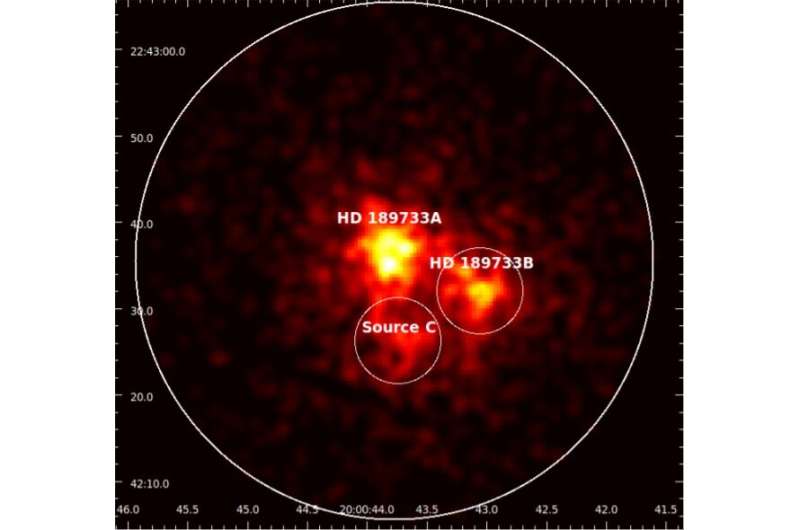February 8, 2022 report
Study investigates X-ray variability of the binary system HD 189733

Astronomers from Italy and Spain have observed a binary system known as HD 189733, using ESA's XMM-Newton satellite. Results of the observational campaign, published January 28 on arXiv.org, deliver essential information regarding the peculiar X-ray variability of this binary.
Located some 63 light years away from the Earth, HD 189733 is a wide binary composed of a K1-type star (HD 189733 A) and a M-type star (HD 189733 B). The primary and secondary stars have masses of about 0.8 and 0.2 solar masses, respectively, while the orbital period of the system is estimated to be 3,200 years. HD 189733 A is known to host an inflated and actively evaporating hot Jupiter exoplanet on 2.2-day orbit.
Detailed studies of stellar X-ray spectra and their time variability, for instance in the form of flares, could be essential in order to better understand the formation and evolution of binary systems. A team of astronomers led by Ignazio Pillitteri of the Palermo Astronomical Observatory in Italy has now analyzed XMM-Newton observations spanning almost eight years with the aim of investigating the X-ray emission of HD 189733 A.
"In this paper, we present a comprehensive analysis of the observations of HD 189733 made with XMM-Newton for a total of ∼ 958 ks. In particular, we study the coronal variability and the occurrence of flares, their duration, shape and energy," the researchers wrote in the paper.
HD 189733 A was 423,600 seconds in the flaring state out of the whole exposure time that was approximately 958,000 seconds. It was found that number of flares observed around the phases of the planetary eclipses is not statistically different from the number of flares during transit phases. The astronomers noted that there is a hint that flares at the secondary transits were more energetic. Additionally, four bright flares of HD 189733 B have been identified in the XMM-Newton data.
The study found that the average temperature of the corona of HD 189733 A is around 0.4 keV. During flares, the temperature of this star rises to about 0.9 keV; however, its corona remained relatively cold, even during the most energetic flaring events.
Furthermore, the astronomers found that in general, the variability of HD 189733 A in X-rays is totally different from the variability observed in the optical band. Trying to explain this difference, they assume that it could be associated with the angular momentum transfer from the exoplanet to its host star.
"We speculate that the stark difference between the activity and the relatively cold flares observed in X-rays and the optical band could be related to the angular momentum transfer from the planet to the star and its influence on the mechanism of magnetic dynamo that produces the corona. Furthermore, the magnetic interaction between the star and the planet could produce a significant part of the observed X-ray emission and variability," the researchers concluded.
More information: I. Pillitteri et al, The X-ray variability of HD 189733 across eight years of XMM-Newton observations. arXiv:2201.12149v2 [astro-ph.SR], arxiv.org/abs/2201.12149
© 2022 Science X Network





















